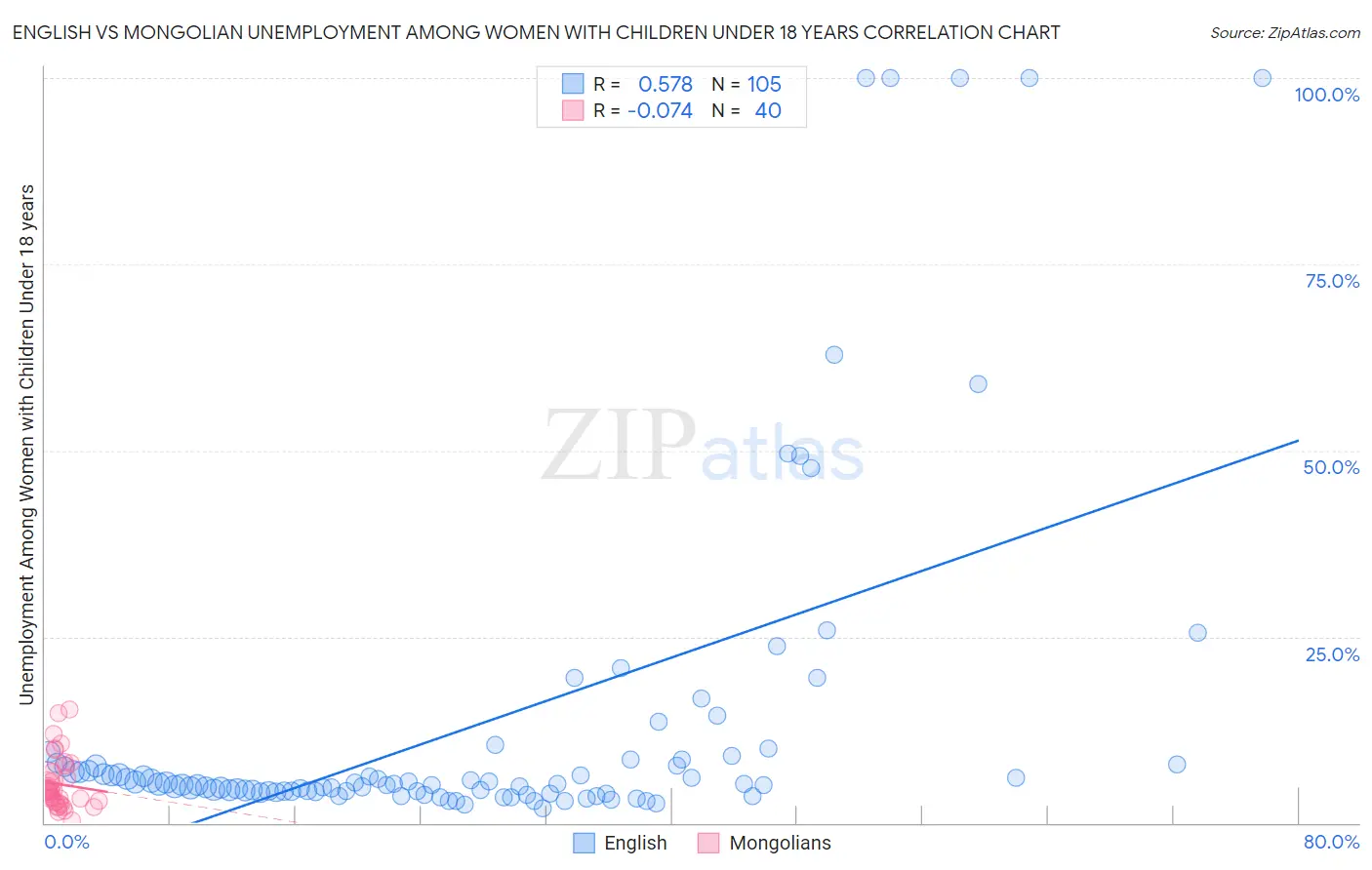English vs Mongolian Unemployment Among Women with Children Under 18 years
COMPARE
English
Mongolian
Unemployment Among Women with Children Under 18 years
Unemployment Among Women with Children Under 18 years Comparison
English
Mongolians
5.0%
UNEMPLOYMENT AMONG WOMEN WITH CHILDREN UNDER 18 YEARS
99.1/ 100
METRIC RATING
39th/ 347
METRIC RANK
5.0%
UNEMPLOYMENT AMONG WOMEN WITH CHILDREN UNDER 18 YEARS
99.2/ 100
METRIC RATING
36th/ 347
METRIC RANK
English vs Mongolian Unemployment Among Women with Children Under 18 years Correlation Chart
The statistical analysis conducted on geographies consisting of 519,569,042 people shows a substantial positive correlation between the proportion of English and unemployment rate among women with children under the age of 18 in the United States with a correlation coefficient (R) of 0.578 and weighted average of 5.0%. Similarly, the statistical analysis conducted on geographies consisting of 138,670,905 people shows a slight negative correlation between the proportion of Mongolians and unemployment rate among women with children under the age of 18 in the United States with a correlation coefficient (R) of -0.074 and weighted average of 5.0%, a difference of 0.15%.

Unemployment Among Women with Children Under 18 years Correlation Summary
| Measurement | English | Mongolian |
| Minimum | 2.0% | 0.40% |
| Maximum | 100.0% | 15.3% |
| Range | 98.0% | 14.9% |
| Mean | 13.2% | 5.2% |
| Median | 5.2% | 4.3% |
| Interquartile 25% (IQ1) | 4.2% | 2.8% |
| Interquartile 75% (IQ3) | 7.9% | 6.5% |
| Interquartile Range (IQR) | 3.7% | 3.6% |
| Standard Deviation (Sample) | 22.5% | 3.5% |
| Standard Deviation (Population) | 22.4% | 3.5% |
Demographics Similar to English and Mongolians by Unemployment Among Women with Children Under 18 years
In terms of unemployment among women with children under 18 years, the demographic groups most similar to English are Bhutanese (5.0%, a difference of 0.10%), Polish (5.0%, a difference of 0.13%), Luxembourger (5.0%, a difference of 0.22%), Greek (5.0%, a difference of 0.25%), and Immigrants from South Central Asia (5.0%, a difference of 0.27%). Similarly, the demographic groups most similar to Mongolians are Polish (5.0%, a difference of 0.020%), Bhutanese (5.0%, a difference of 0.050%), Luxembourger (5.0%, a difference of 0.060%), Immigrants from South Central Asia (5.0%, a difference of 0.12%), and Croatian (5.0%, a difference of 0.32%).
| Demographics | Rating | Rank | Unemployment Among Women with Children Under 18 years |
| Soviet Union | 99.5 /100 | #27 | Exceptional 4.9% |
| Immigrants | Eastern Asia | 99.5 /100 | #28 | Exceptional 4.9% |
| Finns | 99.4 /100 | #29 | Exceptional 4.9% |
| Burmese | 99.4 /100 | #30 | Exceptional 4.9% |
| Cypriots | 99.3 /100 | #31 | Exceptional 5.0% |
| Dutch | 99.3 /100 | #32 | Exceptional 5.0% |
| Croatians | 99.3 /100 | #33 | Exceptional 5.0% |
| Immigrants | South Central Asia | 99.2 /100 | #34 | Exceptional 5.0% |
| Luxembourgers | 99.2 /100 | #35 | Exceptional 5.0% |
| Mongolians | 99.2 /100 | #36 | Exceptional 5.0% |
| Poles | 99.2 /100 | #37 | Exceptional 5.0% |
| Bhutanese | 99.2 /100 | #38 | Exceptional 5.0% |
| English | 99.1 /100 | #39 | Exceptional 5.0% |
| Greeks | 99.0 /100 | #40 | Exceptional 5.0% |
| Immigrants | Bosnia and Herzegovina | 99.0 /100 | #41 | Exceptional 5.0% |
| Eastern Europeans | 98.9 /100 | #42 | Exceptional 5.0% |
| Turks | 98.9 /100 | #43 | Exceptional 5.0% |
| Immigrants | Moldova | 98.9 /100 | #44 | Exceptional 5.0% |
| Immigrants | Malaysia | 98.8 /100 | #45 | Exceptional 5.0% |
| Immigrants | Korea | 98.7 /100 | #46 | Exceptional 5.0% |
| British | 98.7 /100 | #47 | Exceptional 5.0% |